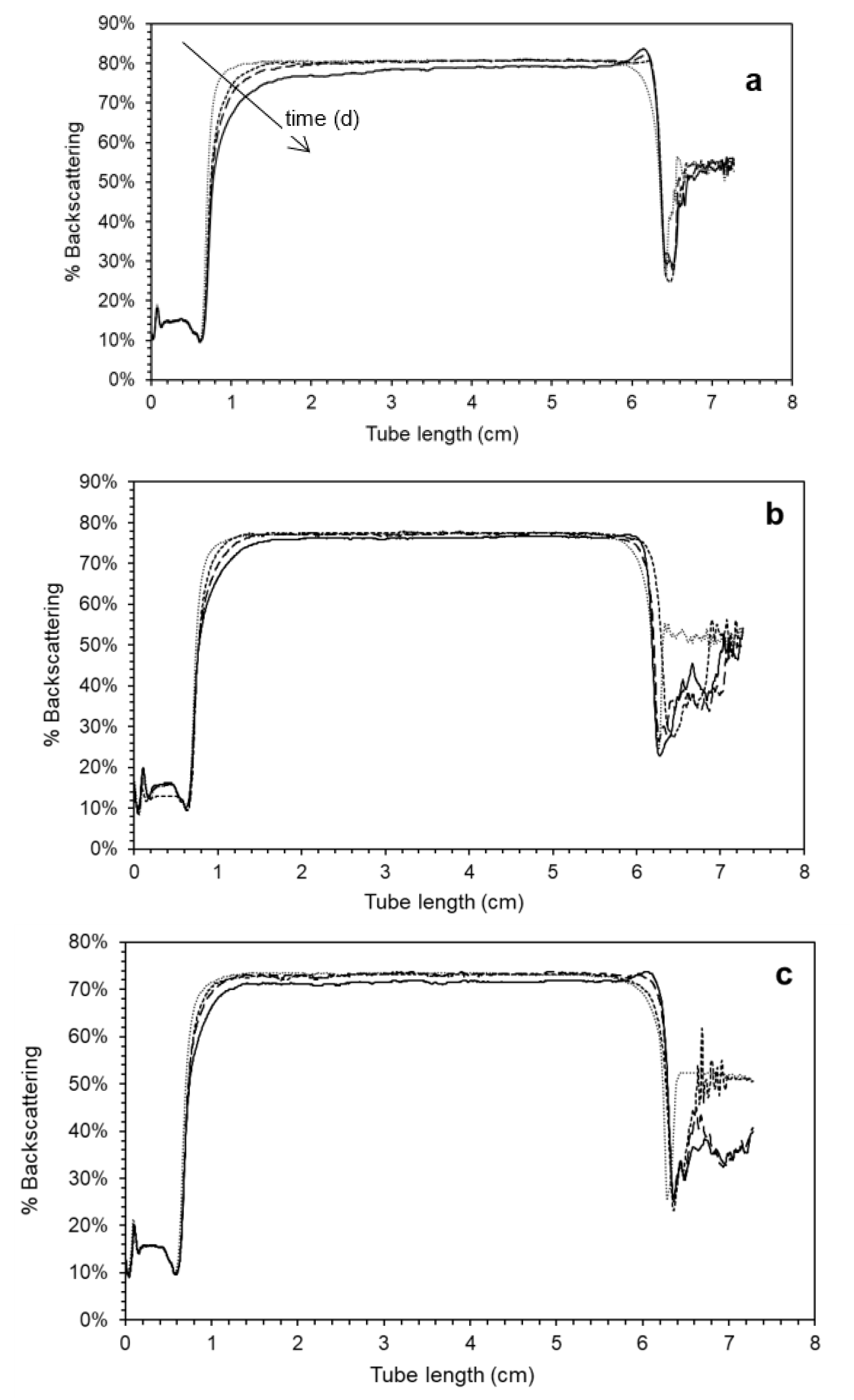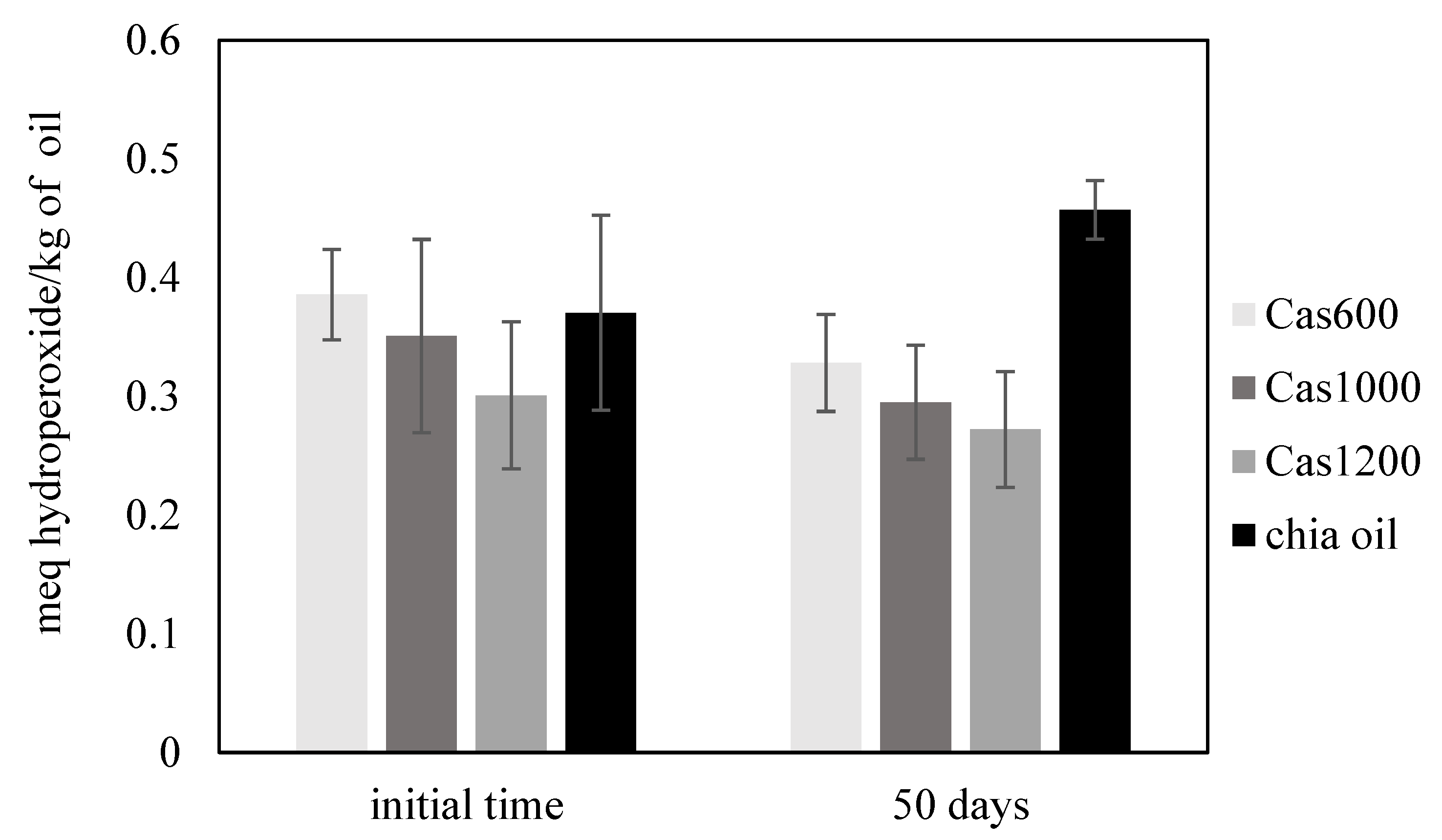Chia Oil-in-Water Nanoemulsions Produced by Microfluidization †
Abstract
1. Introduction
2. Materials and Methods
2.1. Materials
2.2. Preparation of O/W Emulsions
2.3. Emulsions Characterization
2.3.1. Droplet Size
2.3.2. Emulsion Stability
2.3.3. ζ-Potential
2.3.4. Rheological Properties
2.4. Oxidative Stability of Emulsions
2.5. Statically Analysis
3. Results and Discussion
3.1. Emulsion Characterization
3.2. Oxidative Stability of Emulsions
4. Conclusions
Author Contributions
Funding
Institutional Review Board Statement
Informed Consent Statement
Data Availability Statement
Acknowledgments
Conflicts of Interest
References
- Imran, M.; Nadeem, M.; Manzoor, M.F.; Javed, A.; Ali, Z.; Akhtar, M.N.; Muhammad, A.; Yasir, H. Fatty acids characterization, oxidative perspectives and consumer acceptability of oil extracted from pre-treated chia (Salvia hispanica L.) seeds. Lipids Health Dis. 2016, 15, 1–13. [Google Scholar] [CrossRef] [PubMed]
- Tur, J.A.; Bibiloni, M.M.; Sureda, A.; Pons, A. Dietary sources of omega 3 fatty acids: Public health risks and benefits. Br. J. Nutr. 2012, 107, S23–S52. [Google Scholar] [CrossRef]
- Bai, L.; McClements, D.J. Development of microfluidization methods for efficient production of concentrated nanoemulsions: Comparison of single-and dualchannel microfluidizers. J. Colloid Interf. Sci. 2016, 466, 206–212. [Google Scholar] [CrossRef] [PubMed]
- Komaiko, J.S.; Mcclements, D.J. Formation of food-grade nanoemulsions using low-energy preparation methods: A review of available methods. Compr. Rev. Food Sci. Food Saf. 2016, 16, 331–352. [Google Scholar] [CrossRef] [PubMed]
- Monroy-Rodríguez, I.; Monroy-Villagrana, A.; Cornejo-Mazon, M.; García-Pinilla, S.; Hernandez-Sánchez, H.; Gutiérrez-Lopez, G.F. Microfluidization in nanofood engineering. In Food Engineering Series; Hebbar, U., Ranjan, S., Dasgupta, N., Kumar Mishra, R., Eds.; Springer International Publishing: Cham, Switzerland, 2020; pp. 153–175. [Google Scholar] [CrossRef]
- Pan, L.G.; Tomás, M.C.; Añón, M.C. Effect of sunflower lecithins on the stability of water-in-oil and oil-in-water emulsions. J. Surfactants Deterg. 2002, 5, 135–143. [Google Scholar] [CrossRef]
- Julio, L.M.; Ixtaina, V.Y.; Fernández, M.A.; Torres Sánchez, R.M.; Wagner, J.R.; Nolasco, S.M.; Tomás, M.C. Chia seed oil-in-water emulsions as potential delivery systems of ω-3 fatty acids. J. Food Eng. 2015, 162, 48–55. [Google Scholar] [CrossRef]
- Díaz, M.; Dunn, C.M.; McClements, D.J.; Decker, E.A. Use of caseinophosphopeptides as natural antioxidants in oil-in-water emulsions. J. Agric. Food Chem. 2003, 51, 2365–2370. [Google Scholar] [CrossRef] [PubMed]
- Hu, Z.; Zhong, Q. Determination of thiobarbituric acid reactive substances in microencapsulated products. Food Chem. 2010, 123, 794–799. [Google Scholar] [CrossRef]
- McClements, D.J. Emulsion design to improve the delivery of functional lipophilic components. Annu. Rev. Food Sci. Technol. 2010, 1, 241–269. [Google Scholar] [CrossRef] [PubMed]
- Ma, X.; Chatterton, D.E. Strategies to improve the physical stability of sodium caseinate stabilized emulsions: A literature review. Food Hydrocoll. 2021, 119, 1–14. [Google Scholar] [CrossRef]
 ) 1 d, (
) 1 d, ( ) 21 d, (
) 21 d, ( ) 30 d, and (
) 30 d, and ( ) 50 d of storage. Average values (n = 2).
) 50 d of storage. Average values (n = 2).
 ) 1 d, (
) 1 d, ( ) 21 d, (
) 21 d, ( ) 30 d, and (
) 30 d, and ( ) 50 d of storage. Average values (n = 2).
) 50 d of storage. Average values (n = 2).

| System | ζ-Potential (mV) | D3.2 (µm) | |
|---|---|---|---|
| 0 d | 50 d | ||
| Cas600 | −41 ± 4 a | 0.127 ± 0.001 aF | 0.124 ± 0.001 aG |
| Cas1000 | −40 ± 1 a | 0.107 ± 0.02 bH | 0.109 ± 0.002 bH |
| Cas1200 | −35 ± 4 b | 0.125 ± 0.00 cI | 0.1240 ± 0.0005 aJ |
Publisher’s Note: MDPI stays neutral with regard to jurisdictional claims in published maps and institutional affiliations. |
© 2022 by the authors. Licensee MDPI, Basel, Switzerland. This article is an open access article distributed under the terms and conditions of the Creative Commons Attribution (CC BY) license (https://creativecommons.org/licenses/by/4.0/).
Share and Cite
Censi, N.; Julio, L.M.; Tomás, M.C. Chia Oil-in-Water Nanoemulsions Produced by Microfluidization. Biol. Life Sci. Forum 2022, 17, 14. https://doi.org/10.3390/blsf2022017014
Censi N, Julio LM, Tomás MC. Chia Oil-in-Water Nanoemulsions Produced by Microfluidization. Biology and Life Sciences Forum. 2022; 17(1):14. https://doi.org/10.3390/blsf2022017014
Chicago/Turabian StyleCensi, Nicolás, Luciana M. Julio, and Mabel C. Tomás. 2022. "Chia Oil-in-Water Nanoemulsions Produced by Microfluidization" Biology and Life Sciences Forum 17, no. 1: 14. https://doi.org/10.3390/blsf2022017014
APA StyleCensi, N., Julio, L. M., & Tomás, M. C. (2022). Chia Oil-in-Water Nanoemulsions Produced by Microfluidization. Biology and Life Sciences Forum, 17(1), 14. https://doi.org/10.3390/blsf2022017014






